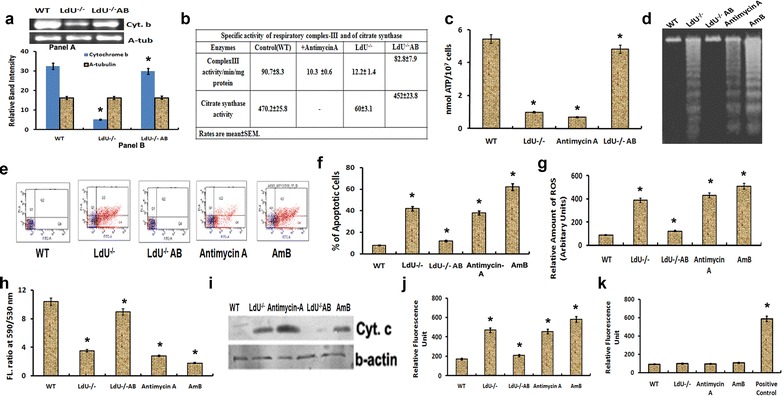Fig. 6.

Silencing of LdUMSBP induces Apoptosis like cell death by disrupting the Electron Transport Chain. a Expression level of Cyt. b in WT, LdU−/−, and LdU−/−AB parasites by semiquantitative RT-PCR. b Specific activity of complex-III of ETC and of citrate synthase activity in WT, LdU−/−, and LdU−/−AB parasites. c Production of intracellular ATP of WT, LdU−/−, antimycin A (positive control) treated and LdU−/−AB parasites. d Oligosomal degradation of DNA of the indicated parasites. Deletion of LdUMSBP induces DNA degradation in LdU−/− parasites. Genetic complementation (LdU−/−AB) completely reduces the DNA degradation. e Assay of cell death taking the same set of parasite used in DNA degradation assay by flow cytometry. Figure denotes differential changes in apoptotic population (Annexin-V positive but PI negative) (as expressed by % of apoptotic cells) in response to deletion and complementation of LdUMSBP alleles. f Graphical representation of % of apoptotic cells. g Generation of intracellular ROS by WT, antimycin A treated and LdU−/− parasites. h Determination of Ψm as described in materials and methods of indicated parasites. i Western blotting to analyse the release of Cyt. c in the cytosolic fraction in response to deletion of LdUMSBP and Antimycin A treatment. j Determination of Metacaspase like protease activity. Increased fluorescence intensity indicates increased metacaspase-like protease activity. k Determination of membrane integrity by measuring released lactate dehydrogenase. In all experiments AmB was used as positive control. Asterisk denotes that the data are significant (p < 0.005)
